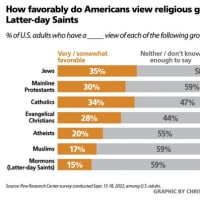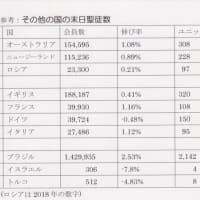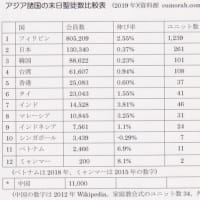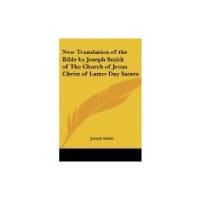
ジョン・P・ホフマン著「日出ずる国のモルモン教徒」
出版される
ブリガムヤング大学の社会学者ジョン・P・ホフマンが、
日本の北部(北海道)の小さな教会(ユニット)の会員
を対象に調査を行い、改宗の動機や信仰生活などについ
て質的分析を行ったもの。2007年1月刊行。価格70ドル。
なお、BYU院生助手であったチャーリー・V・モルガ
ン(現カリフォルニア大学アーバイン校教員)が2000年
9月から翌年8月にかけて北陸で面接調査を含めて作業
を行った分析も含まれていると思われる。内容には「教
会への加入、教会からの離反」「末日聖徒であることの
意味」「アイデンティティのバランス -- 軋轢と調和」
「アイデンティティとしての教会活動」「日本人として
のアイデンティティとモルモン教徒としてのアイデンテ
ィティ」などの章が目次に見える。社会学者による学術
的な著書である。
原題:Japanese Saints: Mormons in the Land of the
Rising Sun
著者: John P. Hoffmann
出版社: Lexington Books
一部は既刊の下記の書に掲載されているものと考えられ
る。
Hoffmann, John P., and Charlie V. Morgan. "Japanese
Members of the LDS Church: A Qualitative View." Pp.
401-420 in Reid Neilson and Van C. Gessel, eds.,
"Taking the Gospel to the Japanese, 1901-2001." Provo,
UT: Brigham Young University Press (2006)
なお、この書物出版の情報は桑畑俊一氏から得たもので、
インターネットから得た内容で補足してある。本そのも
のはまだ入手していないので、後日改めてコメントした
いと思っている。
目次
Japanese Saints: Mormons in the Land of the Rising Sun,
John P. Hoffman, Lexington Books 2007
Contents
Acknowledgements
Note about Names and Style ix xi
1 Introduction 1
2 Japanese History, Christianity, and the LDS
Church 13
3 Toward an Understanding of Religious and Japanese
Identities 51
4 Joining the Church, Leaving the Church 87
5 What It Means To Be A Latter-day Saint 115
6 Identity Balance: Conflicts and Reconciliations
135
7 Church Work as Identity Work 153
8 Missionary Work in Japan 167
9 Japanese Identity, Mormon Identity: Sketches and
Conclusions 187
Appendix: Research Methods 197
Bibliography 20?
Index 227 (目次の項 '09/4/24 記入)
*A review by Armand Mauss (part) ”Social Forces" Vol. 87, Issue 3, Mar. 2009 (posted Apr. 14, 2018)
This is a unique book that will help to fill a scholarly void. Although The Church of Jesus Christ of Latter-day Saints or Mormon Church has done missionary work among the Japanese for a century, this is the first scholarly book in English on the subject. There is a sizeable body of other academic literature on this topic, including theses, articles and edited collections, all duly cited by the present author, but his is the first monograph, and it is issued by a decent press known for many other scholarly works.
The book has nine chapters, an Appendix on data and research methods, a thorough bibliography and a brief index. After a short introductory chapter explaining the need for such a book, the next two chapters go to some length in creating a historical and then a theoretical context for understanding the Mormon experience in Japan. The social-psychological literature on the creation, maintenance and change of identity provides the theoretical framework for the book. Chapters 4 through 7 apply that framework to a discussion of the entire process by which the Japanese converts acquire, maintain and (in many cases) relinquish their Mormon identity. The constant tension between the Mormon and the traditional Japanese identity is a sub-theme of the book. Chapter 8 shows us how these processes are perceived by the missionaries, both American and Japanese, who do the "identity work" of proselytizing. Chapter 9 summarizes the work and then considers, among other things, the prospects for a "Japanized" Mormon identity and understanding of the religion.
I had been asked to review a draft of this manuscript in 2004, so naturally I was curious to see if my comments and suggestions then had made much difference. Apparently they had not. The published version is virtually identical to the earlier one (except for the short introductory and concluding chapters). Even the few misspellings of [End Page 1697] Japanese words that I warned about have been retained! Authors are entitled to ignore their critics, of course, and I will concede that my original criticisms seemed less serious to me as I saw how well the book turned out in spite of them. Yet I continue to believe that there was too much space spent on general history in Chapter 2, and that the review in Chapter 3 of identity theory was longer and more complicated than necessary.
In some ways, the book offers us both more and less than at first meets the eye – less, because the pool of informants from which the interviews come is both limited and selective, so that generalizing to the Mormon population of Japan is risky. On the other hand, the reader not well informed about religion in Japan will learn a lot from the author's review of the history of Japan and of Christianity there, and not just about Mormonism in Japan. Furthermore, the reader will learn much about conversion, retention, defection and identity struggles as generic processes in the exporting of any religion throughout the world. Indeed, the generic nature of these processes was not acknowledged consistently enough in this book, sometimes leaving the erroneous impression that they were unique to Mormonism in Japan.
Critics can point to two other weaknesses in this otherwise solid accomplishment: (1. Interview data came only from 22 active members of a Latter-day Saint congregation of about 120 in northern Japan, plus some 25 missionaries. As the Appendix makes clear, these interview subjects were not haphazardly selected, but neither could they be considered a systematic sample. (2. The excerpts from the interview data, and the conclusions drawn from them at the end of each chapter, tend to highlight the successful survivors of the struggle to reconcile the Japanese and the Mormon identities. Only rarely (pp.106-09, 191-93) does the author acknowledge the casualties in this struggle, which are obviously numerous with a retention rate of 25 percent or less. To be sure, defection is a painful topic for a missionary church, but the only hope of reducing...
https://academic.oup.com/sf/article-abstract/87/3/1697/2235398




















※コメント投稿者のブログIDはブログ作成者のみに通知されます